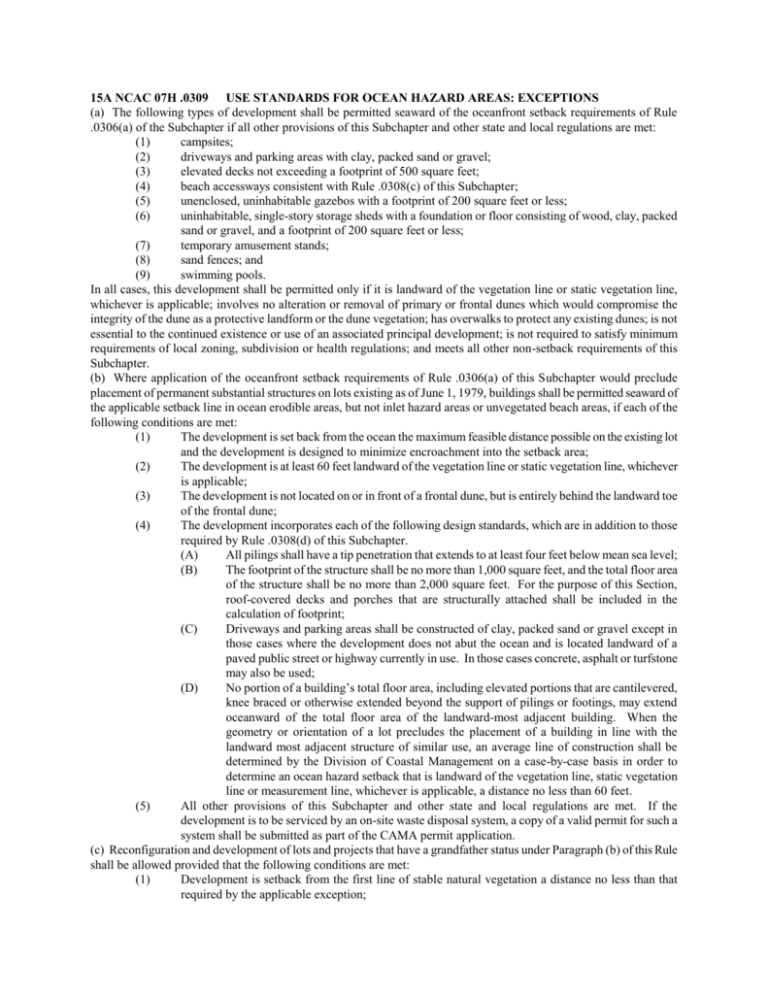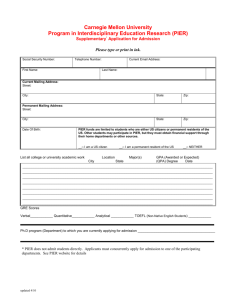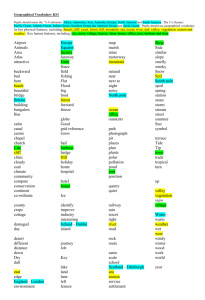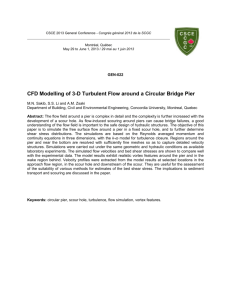15A NCAC 07H .0309 USE STANDARDS FOR OCEAN HAZARD
advertisement

15A NCAC 07H .0309 USE STANDARDS FOR OCEAN HAZARD AREAS: EXCEPTIONS (a) The following types of development shall be permitted seaward of the oceanfront setback requirements of Rule .0306(a) of the Subchapter if all other provisions of this Subchapter and other state and local regulations are met: (1) campsites; (2) driveways and parking areas with clay, packed sand or gravel; (3) elevated decks not exceeding a footprint of 500 square feet; (4) beach accessways consistent with Rule .0308(c) of this Subchapter; (5) unenclosed, uninhabitable gazebos with a footprint of 200 square feet or less; (6) uninhabitable, single-story storage sheds with a foundation or floor consisting of wood, clay, packed sand or gravel, and a footprint of 200 square feet or less; (7) temporary amusement stands; (8) sand fences; and (9) swimming pools. In all cases, this development shall be permitted only if it is landward of the vegetation line or static vegetation line, whichever is applicable; involves no alteration or removal of primary or frontal dunes which would compromise the integrity of the dune as a protective landform or the dune vegetation; has overwalks to protect any existing dunes; is not essential to the continued existence or use of an associated principal development; is not required to satisfy minimum requirements of local zoning, subdivision or health regulations; and meets all other non-setback requirements of this Subchapter. (b) Where application of the oceanfront setback requirements of Rule .0306(a) of this Subchapter would preclude placement of permanent substantial structures on lots existing as of June 1, 1979, buildings shall be permitted seaward of the applicable setback line in ocean erodible areas, but not inlet hazard areas or unvegetated beach areas, if each of the following conditions are met: (1) The development is set back from the ocean the maximum feasible distance possible on the existing lot and the development is designed to minimize encroachment into the setback area; (2) The development is at least 60 feet landward of the vegetation line or static vegetation line, whichever is applicable; (3) The development is not located on or in front of a frontal dune, but is entirely behind the landward toe of the frontal dune; (4) The development incorporates each of the following design standards, which are in addition to those required by Rule .0308(d) of this Subchapter. (A) All pilings shall have a tip penetration that extends to at least four feet below mean sea level; (B) The footprint of the structure shall be no more than 1,000 square feet, and the total floor area of the structure shall be no more than 2,000 square feet. For the purpose of this Section, roof-covered decks and porches that are structurally attached shall be included in the calculation of footprint; (C) Driveways and parking areas shall be constructed of clay, packed sand or gravel except in those cases where the development does not abut the ocean and is located landward of a paved public street or highway currently in use. In those cases concrete, asphalt or turfstone may also be used; (D) No portion of a building’s total floor area, including elevated portions that are cantilevered, knee braced or otherwise extended beyond the support of pilings or footings, may extend oceanward of the total floor area of the landward-most adjacent building. When the geometry or orientation of a lot precludes the placement of a building in line with the landward most adjacent structure of similar use, an average line of construction shall be determined by the Division of Coastal Management on a case-by-case basis in order to determine an ocean hazard setback that is landward of the vegetation line, static vegetation line or measurement line, whichever is applicable, a distance no less than 60 feet. (5) All other provisions of this Subchapter and other state and local regulations are met. If the development is to be serviced by an on-site waste disposal system, a copy of a valid permit for such a system shall be submitted as part of the CAMA permit application. (c) Reconfiguration and development of lots and projects that have a grandfather status under Paragraph (b) of this Rule shall be allowed provided that the following conditions are met: (1) Development is setback from the first line of stable natural vegetation a distance no less than that required by the applicable exception; (2) Reconfiguration shall not result in an increase in the number of buildable lots within the Ocean Hazard AEC or have other adverse environmental consequences. For the purposes of this Rule, an existing lot is a lot or tract of land which, as of June 1, 1979, is specifically described in a recorded plat and which cannot be enlarged by combining the lot or tract of land with a contiguous lot(s) or tract(s) of land under the same ownership. The footprint is defined as the greatest exterior dimensions of the structure, including covered decks, porches, and stairways, when extended to ground level. (d) The following types of water dependent development shall be permitted seaward of the oceanfront setback requirements of Rule .0306(a) of this Section if all other provisions of this Subchapter and other state and local regulations are met: (1) piers providing public access; and (2) maintenance and replacement of existing state-owned bridges and causeways and accessways to such bridges. (e) Replacement or construction of a pier house associated with an ocean pier shall be permitted if each of the following conditions is met: (1) The ocean pier provides public access for fishing and other recreational purposes whether on a commercial, public, or nonprofit basis; (2) Commercial, non-water dependent uses of the ocean pier and associated pier house shall be limited to restaurants and retail services. Residential uses, lodging, and parking areas shall be prohibited; (3) The pier house shall be limited to a maximum of two stories; (4) A new pier house shall not exceed a footprint of 5,000 square feet and shall be located landward of mean high water; (5) A replacement pier house may be rebuilt not to exceed its most recent footprint or a footprint of 5,000 square feet, whichever is larger; (6) The pier house shall be rebuilt to comply with all other provisions of this Subchapter; and (7) If the pier has been destroyed or rendered unusable, replacement or expansion of the associated pier house shall be permitted only if the pier is being replaced and returned to its original function. (f) In addition to the development authorized under Paragraph (d) of this Rule, small scale, non-essential development that does not induce further growth in the Ocean Hazard Area, such as the construction of single family piers and small scale erosion control measures that do not interfere with natural oceanfront processes, shall be permitted on those nonoceanfront portions of shoreline that exhibit features characteristic of an Estuarine Shoreline. Such features include the presence of wetland vegetation, and lower wave energy and erosion rates than in the adjoining Ocean Erodible Area. Such development shall be permitted under the standards set out in Rule .0208 of this Subchapter. For the purpose of this Rule, small scale is defined as those projects which are eligible for authorization under 15A NCAC 07H .1100, .1200 and 07K .0203. (g) Transmission lines necessary to transmit electricity from an offshore energy-producing facility may be permitted provided that each of the following conditions is met: (1) The transmission lines are buried under the ocean beach, nearshore area, and primary and frontal dunes, all as defined in Rule 07H .0305, in such a manner so as to ensure that the placement of the transmission lines involves no alteration or removal of the primary or frontal dunes; and (2) The design and placement of the transmission lines shall be performed in a manner so as not to endanger the public or the public's use of the beach. History Note: Authority G.S. 113A-107(a); 113A-107(b); 113A-113(b)(6)a; 113A-113(b)(6)b; 113A-113(b)(6)d; 113A-124; Eff. February 2, 1981; Amended Eff. June 1, 2010; February 1, 2006; September 17, 2002 pursuant to S.L. 2002-116; August 1, 2000; August 1, 1998; April 1, 1996; April 1, 1995; February 1, 1993; January 1, 1991; April 1, 1987.








